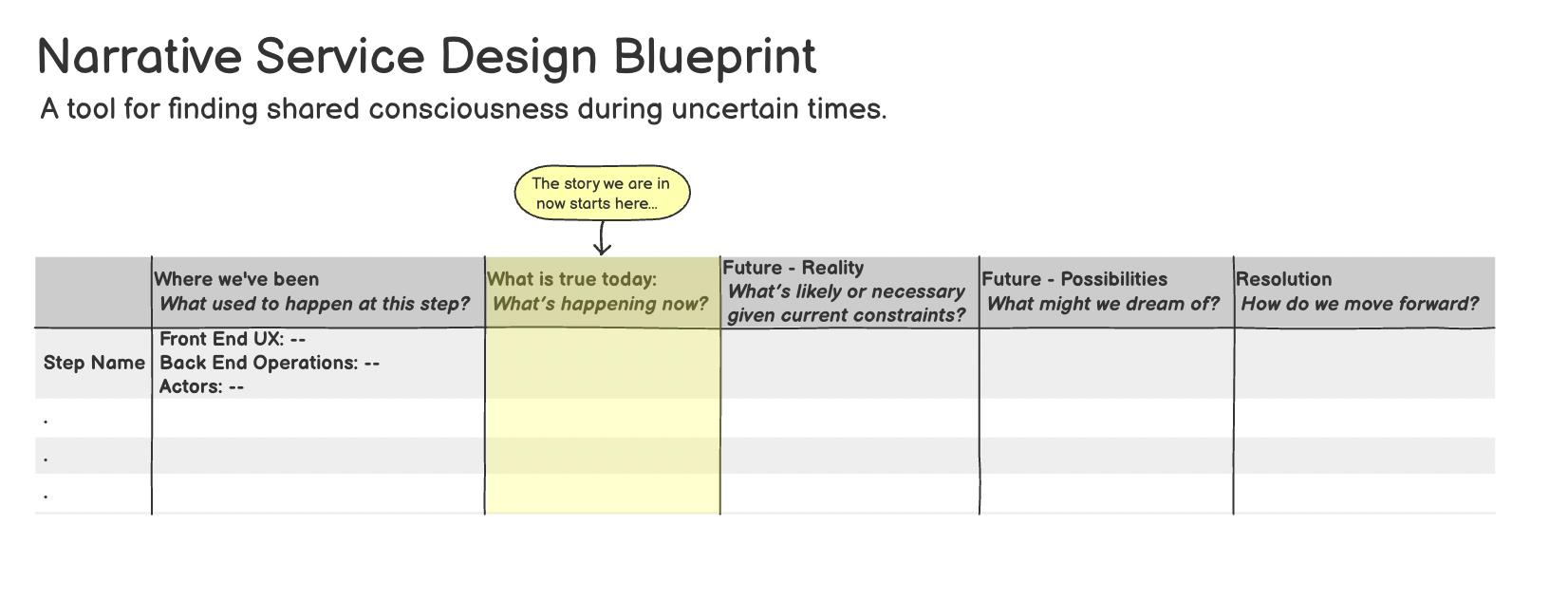what story are we in now?
The following contains a new leadership tool for navigating uncertainty, one that blends narrative ethics from clinical care with service design from systems thinking. For leaders asking: Where do we go from here?
In an era of polycrisis, rapid change, and team misalignment, old leadership tools are falling short. Traditional strategic planning doesn’t account for emotion. Org design doesn’t reveal what really matters to people. And all levels are stuck holding grief they don't know how to process.
Hearing What Matters
The power of storytelling and deeply understanding what matters most to patients and families in the hospital remains an invaluable tool in clinical decision making. Providers are often with patients and families when there has been an acute, life-altering event, a moment of peripeteia. What naturally follows is a need to resolve a decision about where to go next in the course of care. If done with the right level of care, humility, and deep listening, patients and their loved ones are given the gift of clarity and a sense of agency to move forward, a moment of anagnorisis.
I’m not a clinical ethicist, but reflecting on narrative ethics has made me realize these ideas belong far beyond the bedside. Narrative ethics is the practice of asking, and deeply listening to, what matters most to someone at a turning point. In hospitals, it guides decisions at the edge of life and death. In organizations, it can help us decide what to protect, what to let go, and where to steer next.
Narrative ethics is a tool for widening our understanding of a person and their values in a given moment. It’s less about helping patients understand why they got here, and more about how they got here as a way to illuminate how we might proceed.
To begin an ethics consultation, the care provider might ask:
- What has mattered most to you throughout the course of your life?
- What matters to you now?
- Who is most important to this story for you, and why?
- What story are we in now?
- How would you like this story to end?
As an ethicist, you might ask these questions separately of the patient, individual family members, and the care team. Your job is to hold the space for whatever answers and wishes arise from all parties.
Martha Montello, who introduced me to this caring and complex topic, emphasizes that the goal of this work is less about solution (what to do) and more about resolution (how to do it and how to move forward). She writes:
"The meaning of resolution in narrative ethics is closer to what resolution means in music: progressing from a dissonance to a consonance. The word “progressing” is important here... We are bit players in an ongoing drama, there with a patient or family for only a scene or a chapter in a life narrative."
Tracing the Whole Picture
And just as individual stories shape decisions, structural stories shape systems.
Shifting entirely to decades-old business process improvement techniques, mapping the needs of your constituents to the back-end operations of your organization is just as critical as storytelling during times of uncertainty.
In 1967, computer scientist Melvin Conway asked: how do committees invent? He concluded:
“Organizations which design systems (or products, or services) are constrained to produce designs which are copies of the communication structures of these organizations.”
This observation — now known as Conway’s Law — is often invoked when an organization digs deep enough to understand why a user's experience has become disgracefully disjointed, and realizes it likely has something to do with anti-collaborative workflows.
The antidote to Conway's Law is service design. A user-centric approach to map needs, actors, and processes in the name of delivering seamless user experience. Service blueprinting, a popular service design tool, models the experience you wish to see in the world while staying grounded in operational reality.
So often you see beautiful user journeys that follow a happy user along a trodden path. But when you layer on the operational and human resource needs, only then does a real conversation about what’s possible begin, or resolve quickly.
(Enter stage left) Narrative service design
By blending narrative ethics with service design, we create a blueprint for decision-making that honors both what people feel and how systems function. It’s not about solving uncertainty, it’s about leading through it, with presence, preparation, and shared consciousness.
Starting with a whole-picture view of the current state, buttressed by where we’ve been, where we’re likely going, where we dream of going, and how we proceed, sets the stage for ongoing alignment.

This tool helps teams:
- Acknowledge the story so far (Where we've been),
- Capture what’s currently true (front-end and back-end),
- Explore the future we expect (Reality),
- Open space for the future we desire (Possibilities),
- Achieve clarity over how to move forward (Resolution)
Final Word
There is no single way to solve complex problems. But as a leader, you do have a duty to resolve. In times of uncertainty, leaders don’t need all the answers but they do need resolution. Not the perfect solution, but a way forward that honors the past, accepts the present, and builds shared meaning about the future.
In moments of uncertainty, which tools will you reach for? Will they align not just plans and processes but people, emotions, and meaning?
Related Reading
- Chekhov, A. (1886). Misery. (full text)
- Stevens, W. (1921). The Snow Man. Poetry magazine .(full text)
- Conway, M. E. (1968). HOW DO COMMITTEES INVENT? (full text)
- Montello, M. (2014). Narrative Ethics. Hastings Center Report, 44(s1). https://doi.org/10.1002/hast.260
- McChrystal, S. (2015) Team of Teams: New Rules of Engagement for a Complex World.
- Everything I know about practical service design is from the teachings of Erika Flowers and Morgan Brandon Miller. Buy their book!